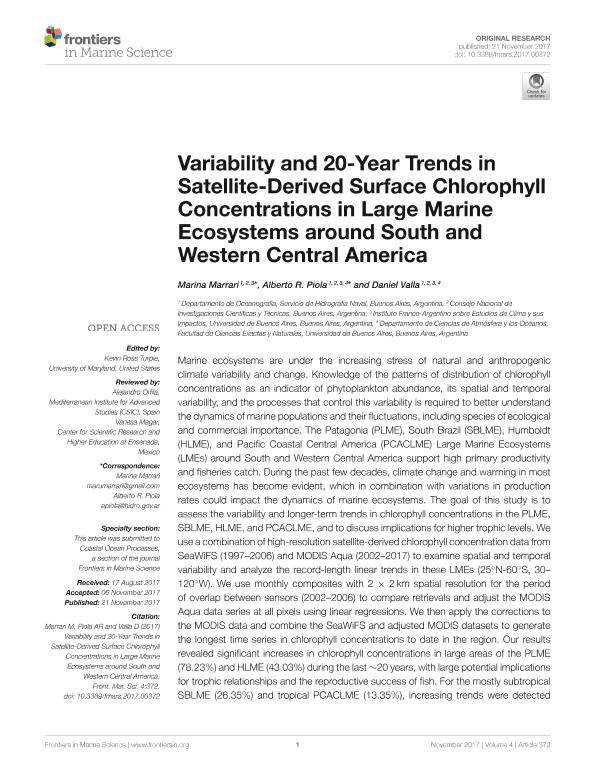Mostrar el registro sencillo del ítem
dc.contributor.author
Marrari, Marina

dc.contributor.author
Piola, Alberto Ricardo

dc.contributor.author
Valla, Daniel

dc.date.available
2019-04-23T17:58:28Z
dc.date.issued
2017-11
dc.identifier.citation
Marrari, Marina; Piola, Alberto Ricardo; Valla, Daniel; Variability and 20-year trends in satellite-derived surface chlorophyll concentrations in large marine ecosystems around South and Western central America; Frontiers Media S. A; Frontiers in Marine Science; 4; NOV; 11-2017; 1-17
dc.identifier.issn
2296-7745
dc.identifier.uri
http://hdl.handle.net/11336/74815
dc.description.abstract
Marine ecosystems are under the increasing stress of natural and anthropogenic climate variability and change. Knowledge of the patterns of distribution of chlorophyll concentrations as an indicator of phytoplankton abundance, its spatial and temporal variability, and the processes that control this variability is required to better understand the dynamics of marine populations and their fluctuations, including species of ecological and commercial importance. The Patagonia (PLME), South Brazil (SBLME), Humboldt (HLME), and Pacific Coastal Central America (PCACLME) Large Marine Ecosystems (LMEs) around South and Western Central America support high primary productivity and fisheries catch. During the past few decades, climate change and warming in most ecosystems has become evident, which in combination with variations in production rates could impact the dynamics of marine ecosystems. The goal of this study is to assess the variability and longer-term trends in chlorophyll concentrations in the PLME, SBLME, HLME, and PCACLME, and to discuss implications for higher trophic levels. We use a combination of high-resolution satellite-derived chlorophyll concentration data from SeaWiFS (1997-2006) and MODIS Aqua (2002-2017) to examine spatial and temporal variability and analyze the record-length linear trends in these LMEs (25°N-60°S, 30-120°W). We use monthly composites with 2 × 2 km spatial resolution for the period of overlap between sensors (2002-2006) to compare retrievals and adjust the MODIS Aqua data series at all pixels using linear regressions. We then apply the corrections to the MODIS data and combine the SeaWiFS and adjusted MODIS datasets to generate the longest time series in chlorophyll concentrations to date in the region. Our results revealed significant increases in chlorophyll concentrations in large areas of the PLME (78.23%) and HLME (43.03%) during the last ~20 years, with large potential implications for trophic relationships and the reproductive success of fish. For the mostly subtropical SBLME (26.35%) and tropical PCACLME (13.35%), increasing trends were detected only in relatively small regions, while changes in the PLME and HLME are widespread. Results from this study contribute to a better understanding of the potential effects of environmental change on ecosystem dynamics and provide new tools to assess longer-term trends in satellite chlorophyll concentrations.
dc.format
application/pdf
dc.language.iso
eng
dc.publisher
Frontiers Media S. A
dc.rights
info:eu-repo/semantics/openAccess
dc.rights.uri
https://creativecommons.org/licenses/by-nc-sa/2.5/ar/
dc.subject
Central America
dc.subject
Chlorophyll Concentrations
dc.subject
Climate Change
dc.subject
Large Marine Ecosystems
dc.subject
Modis
dc.subject
Seawifs
dc.subject
South America
dc.subject
Trends
dc.subject.classification
Meteorología y Ciencias Atmosféricas

dc.subject.classification
Ciencias de la Tierra y relacionadas con el Medio Ambiente

dc.subject.classification
CIENCIAS NATURALES Y EXACTAS

dc.title
Variability and 20-year trends in satellite-derived surface chlorophyll concentrations in large marine ecosystems around South and Western central America
dc.type
info:eu-repo/semantics/article
dc.type
info:ar-repo/semantics/artículo
dc.type
info:eu-repo/semantics/publishedVersion
dc.date.updated
2019-04-23T17:13:53Z
dc.journal.volume
4
dc.journal.number
NOV
dc.journal.pagination
1-17
dc.journal.pais
Suiza

dc.description.fil
Fil: Marrari, Marina. Consejo Nacional de Investigaciones Científicas y Técnicas; Argentina. Ministerio de Defensa. Armada Argentina. Servicio de Hidrografía Naval. Departamento Oceanografía; Argentina. Universidad de Buenos Aires; Argentina
dc.description.fil
Fil: Piola, Alberto Ricardo. Consejo Nacional de Investigaciones Científicas y Técnicas; Argentina. Ministerio de Defensa. Armada Argentina. Servicio de Hidrografía Naval. Departamento Oceanografía; Argentina. Universidad de Buenos Aires; Argentina. Universidad de Buenos Aires. Facultad de Ciencias Exactas y Naturales. Departamento de Ciencias de la Atmósfera y los Océanos; Argentina
dc.description.fil
Fil: Valla, Daniel. Consejo Nacional de Investigaciones Científicas y Técnicas; Argentina. Ministerio de Defensa. Armada Argentina. Servicio de Hidrografía Naval. Departamento Oceanografía; Argentina. Universidad de Buenos Aires; Argentina. Universidad de Buenos Aires. Facultad de Ciencias Exactas y Naturales. Departamento de Ciencias de la Atmósfera y los Océanos; Argentina
dc.journal.title
Frontiers in Marine Science
dc.relation.alternativeid
info:eu-repo/semantics/altIdentifier/url/https://www.frontiersin.org/articles/10.3389/fmars.2017.00372/full
dc.relation.alternativeid
info:eu-repo/semantics/altIdentifier/doi/https://dx.doi.org/10.3389/fmars.2017.00372
Archivos asociados
